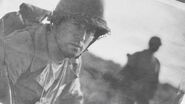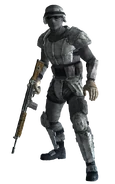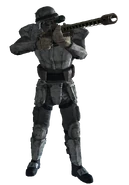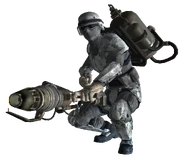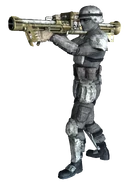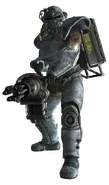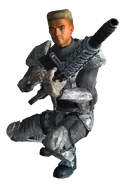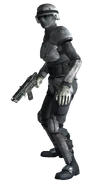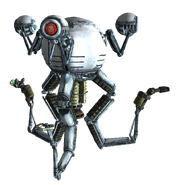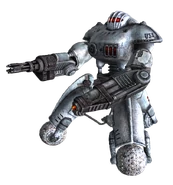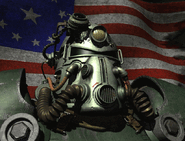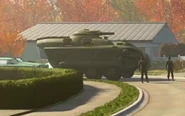No edit summary Tag: sourceedit |
Matthew Paul (talk | contribs) No edit summary Tag: sourceedit |
||
| Line 121: | Line 121: | ||
|footer =[[File:Fo3OA Group Photo.png|240px]]<br />The Anchorage U.S. Army detachment, commanded by General Constantine Chase |
|footer =[[File:Fo3OA Group Photo.png|240px]]<br />The Anchorage U.S. Army detachment, commanded by General Constantine Chase |
||
}}{{Games|FO1|FO2|FO3|FNV|FO4|FOT|VB}} |
}}{{Games|FO1|FO2|FO3|FNV|FO4|FOT|VB}} |
||
| + | |||
| + | {{Quotation| From [[Lexington]] and [[Concord]] to the shores of [[Japan|Iwo Jima]], from the Sea of Tranquility to the [[Anchorage Front Line]], Americans have fought and died through the ages to secure our nation’s freedom. May their sacrifices remind us all that freedom is a privilege afforded to the many, yet hard won by a noble few.|excerpt from a mural in the [[Museum of Freedom]]}} |
||
The '''United States Armed Forces''' were the overall unified military forces of the [[United States]] before the [[Great War]], composed of the United States Army, United States Marine Corps, United States Navy, United States Coast Guard, and United States Air Force. The President served as the Commander-in-Chief of the military, with the Secretary of War, Department of War, and Department of Defense acting as the principal organ by which military policy was carried out. |
The '''United States Armed Forces''' were the overall unified military forces of the [[United States]] before the [[Great War]], composed of the United States Army, United States Marine Corps, United States Navy, United States Coast Guard, and United States Air Force. The President served as the Commander-in-Chief of the military, with the Secretary of War, Department of War, and Department of Defense acting as the principal organ by which military policy was carried out. |
||
Revision as of 01:41, 10 June 2016
The United States Armed Forces were the overall unified military forces of the United States before the Great War, composed of the United States Army, United States Marine Corps, United States Navy, United States Coast Guard, and United States Air Force. The President served as the Commander-in-Chief of the military, with the Secretary of War, Department of War, and Department of Defense acting as the principal organ by which military policy was carried out.
Two centuries after the Great War, a new generation of descendants from the United States Armed Forces were ultimately reorganized into a post-nuclear variant of an ancient United States government bureau called the Department of the Army, otherwise known as the Enclave's military sub-division.[1]
Enclave troopers are trained, conditioned, and disciplined accordingly with advanced training regimens and techniques that diverge directly from that of the old Armed Forces' more specialized, black op units.
The Brotherhood of Steel on the other hand, was originally created by U.S. Army soldiers who rebelled against their standing orders and went AWOL while they were stationed inside of the Mariposa Military Base.
Descendants from these renegade soldiers that originally gave birth to the Brotherhood, likely still serve in some form or another in one or more of the various cells of the Brotherhood today. New initiates into the Brotherhood are conditioned using older, slightly less refined U.S Armed Forces techniques than those that the Enclave utilizes that have been passed down in the Brotherhood for centuries to the succeeding generations comprising it after its creation.
Background
Pre-War
The Armed Forces have a history dating back to 1775, even before the official establishment of the country by the Declaration of Independence on July 4, 1776. The Continental Army, Continental Navy, and Continental Marines were created by the Second Continental Congress in order to defend the newly formed United States of America against the British Empire in the American Revolutionary War.
By 2077, the United States Armed Forces were the world's most powerful military force. Their only rival was the People's Liberation Army of China, both of whose Armed Forces clashed during the Sino-American War in the Alaskan campaign (which included Anchorage) and numerous offensive campaigns waged in China.
The Armed Forces were primarily using energy weapons (laser and plasma) in the field, although due to slow production rates, many troops, in particular those stationed on the Anchorage Front Line were still using regular firearms (such as the R91 assault rifle). Regular infantrymen, regardless of specialization, wore polymer combat armor (Anchorage troops used special winterized versions) while suits of power armor were reserved for Mechanized Cavalry units and special detachments (e.g. Colonel Spindel's group at Mariposa).
In a supportive role, the Army deployed robots―Sentry bots and combat versions of the popular Mister Handy―Mister Gutsy. They used hulking APCs to transport their troops and provide cover in combat. Aerial support was to be provided by next-generation helicopters, the VB-02 Vertibirds, though they were scheduled to enter service in 2085, prototypes may have seen combat at Anchorage.
Fighter support was common and as such many patrolled the U.S. coastline and its national waters.
Post-War
With the nuclear holocaust of 2077 and the dissolution of the chain of command, the U.S. Armed Forces effectively ceased to exist, becoming groups of isolated soldiers with no coordination. Two groups, the Enclave and the Brotherhood of Steel, were founded by former members of the United States Armed Forces. Furthermore, it is implied that the members of the United States' Armed Forces inevitably diffused into the general wastelander population, with some sections stratifying themselves based off perceived military heritage, such as the Desert Rangers of the Texas Commonwealth.
Branches
Army
A year before the Resource Wars, the United States Army helped in the invasion of Mexico to protect U.S. oil interests in the region. Army units were being deployed in Alaska at higher levels than before following the establishment of the Anchorage Frontline in 2059. Much more veritable quantities of troops were transported to the state after the Chinese invasion of Alaska in the winter of 2066 and 2067. The United States Army was utilized in the 2072-2076 annexation process of Canada, and were decisive in defeating the Canadian military and suppressing resistance movements. Later on, in the Sino-American War, Army units were deployed in China proper and its annexed territories with the USMC following the invasion of the supra in 2074. As unrest at home grew in the last years of the war several Army units were deployed within the United States to maintain law and order.
National Guard
The National Guard was a reserve component of the United States Army and served as a domestic defense and disaster relief force during peacetime. However, during wartime, they were deployed abroad as front-line troops alongside other Army units. In the months and years immediately succeeding the Great War, remnants of the National Guard attempted to retain order and law in the United States, assisted by civilian elements such as nurses, and potentially police, as was seen in Germantown. However, due to the high attrition rate suffered as a result of the radiation and anarchy, most, if not all, National Guard units were whittled down by moralities, along with desertion, and eventually disbanded.
Robotics Division
The United States Army Robotics Division was the branch of the army dedicated to the handling and deployment of military robots and associate hardware, and also performed services within lines of robotic research, such as the facility under the RobCo sales & service center in Boston. Known robots used by the division include the assaultron, cyberdog, eyebot, Mister Gutsy, protectron, robobrain, and sentry bot.
Marine Corps
The Marine Corps served in of the American counter invasion of China due to their specialization in amphibious operations.
Before 2077, the US Navy saw widespread deployment, most notably during the Anchorage Reclamation, with the incident between USS Ebon Atoll and USS Interference. The Navy furthermore had bases throughout the United States, notably the Naval Recruiting Center in Maryland's Point Lookout State Park and the Mount Desert Island Naval Facility in Maine. After the war, there are few remaining signs of the Navy, with the only two known ships being a Aircraft Carrier known as Rivet City, located in Washington D.C and the USS Democracy, located on Mount Desert Island.
Air Force
The United States had many Air Force bases throughout the country, some of which are, Adams Air Force Base in Maryland, Nellis Air Force Base in the Mojave Desert, and Elmendorf Air Force Base in Alaska. Some Air Force officers were astronauts for the United States Space Administration.
Notable operations
- By far, the most notable operation is the Anchorage Reclamation, an 11-year campaign to liberate Alaska from the Chinese invaders. Ultimately successful, it was the first large-scale deployment of newly developed T-51b power armor units.
- The annexation of Canada was also performed by the United States military, whose units were also dedicated to keeping the peace―by any means necessary.
- Veterans of the Anchorage campaign were also deployed against their fellow countrymen, to contain food riots.
- The Gobi Campaign, where the U.S. attempted to capture Chinese military facilities in the Gobi Desert. The Gobi Campaign scout rifle was designed for this campaign.
- The Yangtze Campaign, during which Nanjing and Shanghai were occupied by Marines equipped with new, high-tech weapons and armor.
- Soldiers of the U.S. Army's mechanized infantry were stationed on the island of Mambajao in the Philippines on the eve of the Great War.
- Fought in by the United States 135 to 132 years preceding the cumulative Great War, World War II saw the extensive utilization of all branches of the United States Armed Forces onwards from the 8th of December, 1941 with the US Declaration of War against Japan, and successively, numerous other Axis nations and its aftermath witnessed the gradual establishment of an independent air force in 1947.
- It is possible that the Korean War did happen in the Fallout timeline, according to the mural in the Museum of Freedom's depiction of a USMC M46 Patton tank and H19 Chickasaw helicopter, the mainstay of US combat capability during the Korean War.
Bases
Alaska
- Artillery Overlook
- US Army field headquarters
- Chugach Overlook Air Force station
- Elmendorf Air Force Base
- Fire Island Air Force station
West Coast
- Mariposa Military Base
- Lost Hills Security Bunker
- Los Alamos
- Sierra Army Depot
- Toxic Waste Dump Security Bunker
- Nellis Air Force Base
- Hidden Valley
- Hopeville Missile Base
- Command forward depot
- Area 2
Midwest
- Tibbets Military Prison
- MacArthur Army Base
- Bunker Alpha, Beta, Gamma, Delta and Epsilon (original names not known)
- Preoria facility
- Cheyenne Mountain
- Kansas City silo complex
East Coast
Columbia Commonwealth
- Raven Rock (Known as Site R before the war)
- Camp David, Maryland (presidential retreat)
- Fort Bannister
- Fort Constantine
- Fort Independence
- National Guard depot
- Turtledove Detention Camp
- Wheaton Armory
- Rivet City Aircraft Carrier
- The Citadel (formerly the Pentagon)
- National Guard training yard
New England Commonwealth
- Boston mayoral shelter
- Coast Guard Pier
- Federal ration stockpile
- Federal supply cache 84NE
- Federal surveillance center K-21B
- Fort Hagen
- Fort Strong
- Listening Post Bravo
- National Guard training yard
- Recon bunker Theta
- Revere satellite array
- Sentinel Site Prescott
- South Boston Military Checkpoint
- The Nucleus
- The Switchboard
- USAF Satellite Station Olivia
- Wreck of the USS Riptide
See also
Gallery

A mural depicting the United States Armed Forces from 1776-2077, as seen in the Museum of Freedom
.
World War II
Anchorage Reclamation
United States mainland
See also
- American soldier
- Strike Team
References
- ↑ Title found in several Enclave Field Research terminal entries


